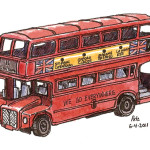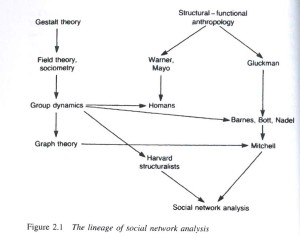This week’s MindMap: Social Networks.
In anticipation of reconceptualizing my semester’s mindmap work, I opted this week to create a more synthesized set of nodes entitled “Rhizome Kinship Patterns.” I also opted not to connect this set to any others as I want to reposition all of these nodes a bit differently. However, had I drawn links beyond the weekly reading / activity, I would have drawn connections to Guattari (earlier iteration), ecology nodes, as well as the node entitled “operationalizing theory.” The key to this group, it seems, is what Scott calls a bridge between theory and practice” (1) by creating an system for analyzing and packaging these “rhizome kinship patterns” of data for the purpose of research. The rhizomes proposed by Deleuze and Guattari seem less pragmatic but represent complex systems in a way that I envisioned being linked to Scott‘s analytical system as an offshoot (no intentional reference to rhizomatic vocabulary).
 In fact, I tried to represent a type of associational pattern with my MindMap juxtaposition of these three (although I am not at all sure I did it justice). In my writing notebook, it actually looked more like I had drawn Scott as the rear wheels of an odd looking bus (Rainie and Wilson’s Operating System), and D&G were the front wheels. Sitting atop it all is the concept of kinship network patterns secured in an oversized luggage rack if you will (in an attempt to suggest that this field of research must be transmitted / moved through theory and theory application). I was trying to visualize here what I thought connected these authors. These three articles seem to be working towards a common purpose: conceptualizing bundles of activity into recognizable forms, useful for analysis and discourse in a quest to discover “what is significant in the situation under investigation” (Scott 54). Since Scott’s data analysis could be seen as one sort of “driving force” behind the theorizing being done by Rainie, Wilson, Deleuze, and Guattari, I thought this bus could be rear-wheel drive.
In fact, I tried to represent a type of associational pattern with my MindMap juxtaposition of these three (although I am not at all sure I did it justice). In my writing notebook, it actually looked more like I had drawn Scott as the rear wheels of an odd looking bus (Rainie and Wilson’s Operating System), and D&G were the front wheels. Sitting atop it all is the concept of kinship network patterns secured in an oversized luggage rack if you will (in an attempt to suggest that this field of research must be transmitted / moved through theory and theory application). I was trying to visualize here what I thought connected these authors. These three articles seem to be working towards a common purpose: conceptualizing bundles of activity into recognizable forms, useful for analysis and discourse in a quest to discover “what is significant in the situation under investigation” (Scott 54). Since Scott’s data analysis could be seen as one sort of “driving force” behind the theorizing being done by Rainie, Wilson, Deleuze, and Guattari, I thought this bus could be rear-wheel drive.
Scott‘s matrices appear almost painfully linear in comparison to the more naturalistic rhizomes of D&G, and perhaps the two offer a way to balance this research engine. Scott (as was mentioned during class, and as we experienced in our in-class activity) dealt in the minutiae of counting those intersecting data packets produced by research on Social Networks. That is, until I considered how this could also be about recognizing patterns erupting into new lines from “the middle” (rhizomes) of a data set. At least, that’s how I felt when trying to wrestle the activity into submission. (I believe I had to tap out to Leslie and Jenny.)
I went back and forth trying to decide how best to position the Rainie and Wellman node as the role mobile communication networks play in creating a realm or axes in which the other theorists might traverse. At first, I thought of making the Rainie/Wellman a sort of “train tracks” but Popplets really didn’t represent that well at all. Therefore, I thought placing it in a “vehicle” mode, being carried by the theorizing and operationalizing done by the other authors, might be suitable. It’s certainly a work in progress, I confess.
Finally, thoughts on my OoS: the concept of rhizomes has crept into my writing time and again this semester, so I was rather looking forward to discussing the representation in our last class. I must confess, I do wish we could have spent more time on that particular element of our reading assignment, as I would have liked to have heard others’ thoughts on the connections between rhizomes and mobile communication systems. Alas, this week’s Popplet also represents that limited scope.
Works Cited:
Deleuze, Gilles and Felix Guattari. A Thousand Plateaus: Capitalism and Schizophrenia. Minneapolis: Univ. of Minnesota Press, 1987.
Rainie, Lee and Barry Wellman. Networked: The New Social Operating System. Cambridge: MIT Press, 2012.
Scott, John. Social Network Analysis: A Handbook. London: Sage Publications, Ltd., 2000.


2 Responses to Mind Map 20 April: Social Networks & Math